Claire Weisz is a founding partner of WXY Architecture + Urban Design, an award-winning, multi-disciplinary practice known for the innovative design of buildings, civic infrastructure, and public open space around New York City.
We first interviewed her weeks before Hurricane Sandy struck New York, but we begin with a follow-up conversation not long after the storm passed.
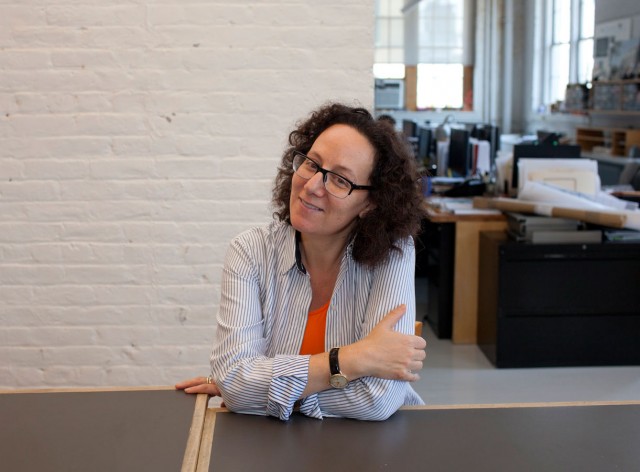
Your recent work for New York includes many projects that fell in the direct path of Hurricane Sandy: newly built Transmitter Park in Greenpoint, public buildings for the beach at Far Rockaway, public architecture in Battery Park that flooded at the tip of Manhattan, and on top of that, you’re now working on the East River Blueway, again at the water’s edge. Tell us about Sandy’s effect on your work.
The parks performed well, and they helped the waterfront absorb the impact from the storm surge. The parks have survived in great measure the salt water in the Battery and Greenpoint and the sand in Far Rockaway. This is taking into consideration that they came back within three weeks of the storm with the help of many volunteers and staff, who devoted hours to clean up those areas.
It is the electrical and mechanical infrastructure that didn’t survive the storm surge, and now the city and state are having to do a great deal to repair and re-install damaged equipment. Hard hit were the offices of many of our public and not-for-profit clients – the Battery whose office and archives were devastated, Jill Weber and her team in the Rockaways whose offices were severely damaged. Many agencies have staff who also have damaged homes.
Did the storm change the way you think about the city’s waterfront? Or might design for the waterfront, going forward?
Yes. It gave us a direct understanding of 100-year, and 500-year, flood lines. This was a reality check in time, space, and effect. Now I will never push to have utility infrastructure within reach of even a 500 year line. But like other catastrophic events it is important to not forget, but to absorb and make a part of all the design decisions one has going forward. Especially when making the hard decision of what to choose to do first.
As a designer of public space, if you were to boil down your reactions to the event, and came up with one take-away message for people to think about, what would it be? What would you like to see the city, and the country, do going forward? Are there adaptive methods or infrastructure would you like to see put into accelerated use?
Prioritize the environment by investing in the resiliency of cities and their residents, and this includes not just New York, but all important waterfront cities.
As a country we have to realize that the best way to save the planet is to support the fact that our cities all over the country — from Detroit to New Orleans — present the best opportunity for lowering our carbon footprint and are critical players in safeguarding our rural spaces and agricultural lands.
We need to make cities — and people who live and work in cities — a national priority, and invest in innovations in social and civic infrastructure like public housing and transportation and all types of public open spaces on and near the waterfront. This will be the best investment we can make in light of the unpredictability of climate change. It was amazing how grateful people were that the 2011 revival of East River ferry service was there to fill in when the subways weren’t running yet.
Do you think the city should build sea gates?
I hope that we will innovate in many areas and this might include sea gates. It is going to test the city and state’s abilities to harness a coordinated effort to do all types of environmental work that is not on the table today, because of permitting and current regulations. New York City in all the five boroughs needs to raise the level of many of the waterfront lands for storm protection and raise critical infrastructure in our public housing, hospitals, sewage treatment and utility buildings.
We need to put back and increase the dunes, invest in cogeneration and a disbursed power and data network, and even build new sea gates, salt marshes, planted berms and other initiatives. This increases the local expertise with rising sea levels; engineers, architects and ecologists might come up with a range of measures that even the Dutch haven’t tried yet. As important as sea gates might also be state-of-the-art local energy generation and data hubs.
Our first interview with Claire Weisz took place weeks before Hurricane Sandy struck New York. That portion follows:
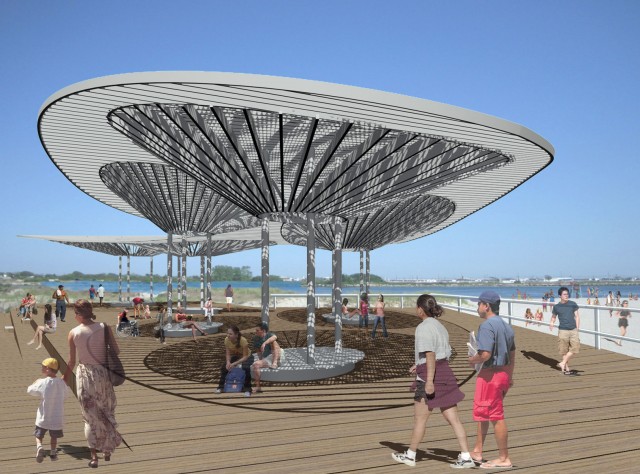
Can you tell us about some of the current projects you’re working on in the city, like the Rockaway project?
The Rockaway project is the architectural piece of a master plan for a very unusual park. It was basically a little tiny park attached to a very large parking lot that was really part of the dunes and was used for dumping, from Beach 9th Street to Beach 30th Street.
When you say it was used for dumping…
People thought it was derelict land and they’d leave things there. The Rockaways is so challenged environmentally from threats of storms and also because it’s such a mix of high poverty areas, relative transportation isolation, and beautiful environment. It’s become an affordable place for people to move, but it also has real economic challenges and it doesn’t have all of the services and amenities. So one of the target parks that the Bloomberg administration focused on was to create a real amenity out there. So, everyone wanted a pool, but they got instead lots of water play, a skateboard park, more playgrounds, a big lawn for concerts, a football field.
The idea is that you have a functional thing, the maintenance office, a comfort station, but then you have this space and there’s kind of a dune park over here.
Attached to a comfort station is an open air classroom or community meeting space — something that can be a shade structure when nothing is happening, but that also becomes the beach pavilion shared by everyone.
Was the intent to service mainly just that community? Or to allow other people from other communities to use it as well?
The intent was to actually do something similar to what happened in Battery Park City. They created the best playground around and everyone from the whole city showed up there, which is not surprising. That was a similar goal in the Rockaways. To open up the neighborhood. And it’s already happened apparently. People are showing up at the skate park [from all over].
Tell us about another project you’re working on.
Another project — also a waterfront park — is called Transmitter Park. It’s part of the Greenpoint master plan, and it ties together…have you seen the zipper benches?
Down at the Staten Island ferry terminal?
Yes. We were doing the master plan for the park, and trying to figure out the urban design and zoning issues of making people feel like the esplanade was going to be public. We started to explore this idea of a bench that then turned and took you somewhere.
Then we realized that that idea of the benches had a lot to do with some of the things we felt urban design needed to do. One is encompassing an environmental idea of public — what they shared, what things, like trees, need to be protected, and how to occupy space and make really good relationships.
Out of that master plan we’re doing one piece of [Transmitter Park] as a park with Dar Walkovitch of A-com, the landscape architects. And we’ve designed the pier and you’ll see all of the railing, and the benches, and this pretty interesting pier. Only half of it’s being built. It’s actually a branching idea. So it’s an idea of saving money actually to do piers, where you only put the pile foundations, the piers, at what we call pods, and then you have these little bridges that connect the pods.
And that’s just phase one?
Well, already, you’ll go down if you take the ferry, already pieces of it are being built, and as each developer develops property parts of the esplanade will be built. And Bushwick Inlet Park is also part of that master plan.
And what else is on the docket for the master plan? How far into the future does the plan reach?
The whole thing is ongoing and it’s happening as we speak. It’s really interesting to see that public realm being built one piece at a time. And I have to say, on Transmitter Park, I went there the other week and there’s this fantastic new little coffee shop in a place that was a dead end street.
It must be satisfying to see these spaces being occupied.
Completely satisfying to see… people have all these ideas. What’s also fun about Transmitter Park is it’s a site for the Nuit Blanche festival, so that’ll be out there.
The other big project that we have under construction is the sanitation garage and salt shed on Spring Street, and that’s also worth talking about. That’s a big industrial, city project to house three garage units, maintain vehicles, store salt, refuel garbage trucks, house sanitation personnel. And you can see the steel going up.
So what kind of things are you thinking of for the sanitation garage?
Well the sanitation garage is designed and it’s now under construction and really that was developed kind of twofold. How to do a beautiful, but yet, not aggressive building; a building that was very calm and could feel like a good neighbor. But the exciting thing about it is that all the guts of it are kind of shielded by louvers which are kind of composed to make subtle differences on the West side and on the South side.
Is that to disguise the building from the rest of the neighborhood?
In a way. In a way it’s to not say in super graphics, “here’s a big garage here” towards the neighborhood, but towards the West Side Highway it’s very apparent. But the idea is to not make it look like an office building — to actually make it look like the piece of industrial civic architecture that it is. [But] there won’t be any public access to it if you’re not a sanitation worker.
We’re trying to really enhance the industrial quality of it and make people want to go in, and we hope there will be tours actually, of the trucks and everything because there’s a lot of potential for that. And to be able to have kids really access and see how big these machines are, what it takes to kind of clean them. So when they see a garbage truck going down the street picking up recycling they’ll have a whole new appreciation for it.
What’s your background?
I grew up in Canada, and I went to the University of Toronto for architecture. Got my professional degree there. Then, the economy was terrible — so basically, on a lark, I decided to go to Los Angeles. Los Angeles at that point was an interesting place to be as an architect. Frank Gehry had just finished his little house, there was all sorts of dialogue about downtown LA, and people were looking at city halls as community.
I felt very lucky; I worked for architect Charles Moore at the Urban Innovations Group and really got interested in the idea of how design and communities and kind of new things happen.
So that’s always been a real interest, but very much as an architect. I would say at a core I am interested in form, space, light and inhabitability, I’ll call it. I’m interested in architecture being the kind of ‘art of people.’
I went back to school at Yale and that’s where I met Mark Yoes, who is my current partner. After I graduated I worked for Agrest and Gandelsonas, who are very interested in…I’ll call it ‘acupuncture planning.’ The idea that you kind of can read a city and do certain things at certain points that will change the city more. They’re very anti-master plan. I was very compelled by that, so I worked for them.
What do you think New York needs more of? Just more green spaces, or something completely different?
I think what New York always needs more of is passionate, visionary supporters, and essentially clients for design, like Friends of the High Line, like Robby Hammond, Joshua David, and Rory Price at the Battery, and Betsy Barlow Rogers.
There are younger people who get ideas in Jamaica, in Far Rockaway, and see something and they want it to be better than anything in the neighborhood — whether it’s better food, better seating, better shade, better wi-fi — on some level I think that’s what’s really fun about New York. There exists an engagement in expectation, and that’s really what we need more of.
There are so many talented people who have ideas about how to make things and do things. The other piece is supporting local talent in the industry — people who make clothes and people who make railings — and trying to find a way to create affordable spaces so that people can make new things.
So there’s no real fixed idea in your head of what New York should be — it’s just sort of a never-ending potential of what could happen?
To me it’s really about the dynamic — this dynamic of saying, making a living and making money and doing well — that ambition to create a business that’s successful is fantastic. But, coupled with that, we want it to be the BEST interior restaurant, we want it to be the best… those two things working together, not just one or the other. I think it’s that. Then you get the unexpected.
More recent design work from WXY includes a popular plan for the development of Pier 40 on the Lower West Side of Manhattan, as shown in this video:
And a plan for the redevelopment of the blocks around Grand Central Terminal, as part of the Municipal Art Society’s new report on the future of East Midtown
About:
Claire Weisz founded WXY Architecture + Urban Design and has focused on creating innovative approaches to public space, structures and cities. She co-founded with Andrea Woodner The Design Trust for Public Space and was its co-executive director. Claire is currently on faculty at New York University’s Wagner School of Public Service and a visiting critic at the University of Toronto, and she has also taught and lectured at Yale University, Parsons’ Graduate Program in the School of Constructed Environments, Columbia University, NJIT and The Pratt Institute. She has served on numerous design award and competition juries and was co-editor of AD magazine’s “Extreme Sites: Greening the Brownfield” issue. Frequently cited in the media and professional circles, Claire is a registered architect in California, New York and New Jersey.
Portait of Claire Weisz by Jessica Bruah; all other images courtesy: WXY
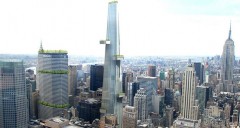
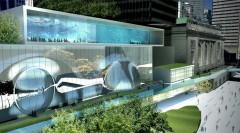
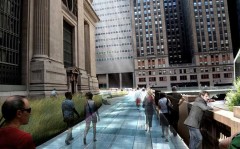
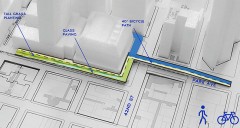
3 Comments
Comments are closed.